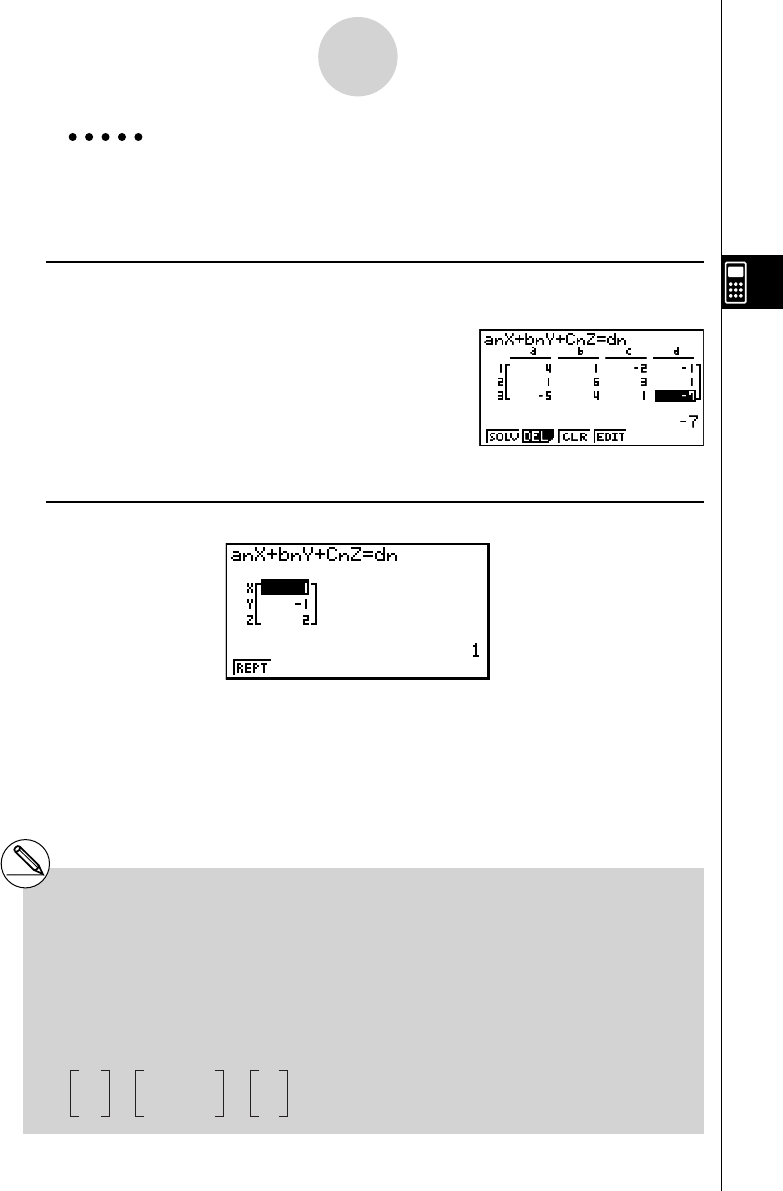User's Manual
Table Of Contents
- Quick-Start
- Precautions when Using this Product
- Contents
- Getting Acquainted— Read This First!
- Chapter 1 Basic Operation
- Chapter 2 Manual Calculations
- Chapter 3 List Function
- Chapter 4 Equation Calculations
- Chapter 5 Graphing
- 5-1 Sample Graphs
- 5-2 Controlling What Appears on a Graph Screen
- 5-3 Drawing a Graph
- 5-4 Storing a Graph in Picture Memory
- 5-5 Drawing Two Graphs on the Same Screen
- 5-6 Manual Graphing
- 5-7 Using Tables
- 5-8 Dynamic Graphing
- 5-9 Graphing a Recursion Formula
- 5-10 Changing the Appearance of a Graph
- 5-11 Function Analysis
- Chapter 6 Statistical Graphs and Calculations
- Chapter 7 Financial Calculation (TVM)
- Chapter 8 Programming
- Chapter 9 Spreadsheet
- Chapter 10 eActivity
- Chapter 11 System Settings Menu
- Chapter 12 Data Communications
- Appendix

20070201
4-1-2
Simultaneous Linear Equations
Example To solve the following simultaneous linear equations for
x , y , and z
4 x + y – 2 z = – 1
x + 6 y + 3 z = 1
– 5 x + 4 y + z = – 7
Procedure
1 m EQUA
2 1 (SIML)
2 (3)
3 e w b w- c w- b w
b w g w d w b w
- f w e w b w- h w
4 1 (SOLV)
Result Screen
# Internal calculations are performed using a 15-
digit mantissa, but results are displayed using
a 10-digit mantissa and a 2-digit exponent.
# Simultaneous linear equations are solved
by inverting the matrix containing the
coeffi cients of the equations. For example,
the following shows the solution (
x 1 , x 2 , x 3 )
of a simultaneous linear equation with three
unknowns.
Because of this, precision is reduced as the
value of the determinant approaches zero. Also,
simultaneous equations with three or more
unknowns may take a very long time to solve.
# An error occurs if the calculator is unable to fi nd
a solution.
# After calculation is complete, you can press
1 (REPT), change coeffi cient values, and then
re-calculate.
–1
=
x
1
x
2
x
3
a
1
b
1
c
1
a
2
b
2
c
2
a
3
b
3
c
3
d
1
d
2
d
3










